
| ||||||
Swindell was teaching on the brand new campus at UC Irvine when it all started. Being an adjunct professor was a second passion of his, his first were always literature and history. When Tracy died Swindell put together for the university a memorial retrospective of his films with a brochure to accompany the film series. A literary agent got hold of the brochure, and called Swindell to ask if he would write a whole biography. Swindell said yes, not really believing that the agent would get a publishing contract for the book. (There was no self-publishing at the time.) But the agent did and Swindell got to work.
Now living in Moraga, Swindell explains that he had met Tracy twice, and it was not necessarily a fond memory. The first time it was as a UCLA student when he proposed to write a memoir on an actor that had been successful both on stage and in movies and suggested Tracy. UCLA got an appointment for Swindell through the Metro Goldwin Mayer studio that had Tracy under contract, but the actor didn't have much time for a student and gave Swindell a hard time when he came for the interview. Swindell ended up writing about someone else. Fifteen years later, he met again with Tracy at a baseball game; the actor remembered him and the interaction was much more cordial.
Every time Swindell wrote about a star, it was after their death. Sometimes he had met them, such as Charles Boyer - whose wife had invited Swindell for dinner after the publication of Tracy's book where she was featured - but most of the times not. Writing these biographies was really an investigative journalist work, digging as much as possible about the star he was interested in, sometimes in cooperation with the family, and sometimes against it. "Spencer Tracy's widow was opposed to my work," remembers Swindell. When one understands that Tracy never divorced her but lived many years with his movie partner Katharine Hepburn, one might understand the wife's wariness.
Swindell says that he always wrote what he wanted to, but it was not without difficulties. When he wrote his biography of John Garfield, the editor refused version after version of the manuscript. "They wanted dirt," says Swindell. The young actor was known for links with the Communist party and Swindell would not elaborate beyond hard facts. Another editor finally was able to publish the book. Swindell says that his books are not a collection of anecdotes for tabloids, they give a real historical perspective of the area and the industry.
Swindell also had difficulty with his biography of Humphrey Bogart that was refused by the editor. The author candidly explains that his perception is that the man, who was a remarkable actor, was somewhat dull as an individual.
Swindell stopped writing biographies years ago, and has no desire for working on the lives of more recent stars. Instead, he has started to write a history of American movies from 1898 to today, a gigantic task that requires not only the use of his sharp and vast memory, but also the consultation of his large personal library that contains references to all the movies ever made in this country. He says that it will take him a few more years to complete it. He does not have a contract for that behemoth, but he shares it with friends and family as he writes it, and expects that academic movie departments will have an interest.
There is of course a bit of nostalgia in Swindell's love of the movies of the 1930s and 40s. He liked a time when everyone went to the movies, when parents could trust the industry, and whole families could see any film together. He explains that the studios had strict guidelines about what could and could not be done. For example, an unpunished crime could not be made. However he believes that this frame did not stifle the directors' creativity, that instead it required more inventiveness on their part.
Swindell's phenomenal memory is also put to good use monthly for moviegoers at the Rheem Theater, as he introduces the classic films he proposes to theater manager Derek Zemrak. With period anecdotes in introducing the movies, Swindell transports the spectators back in time, giving them impression that they too were intimate with the Carry Grants, Betty Davises and other John Waynes.
On March 15 viewers will see "The Woman in the Window" with Edward G. Robinson and Joanne Bennett, and on April 19 "The Rainmaker" with Burt Lancaster and Katharine Hepburn. The classic films always play at 2 p.m. the third Wednesday of the month.
Reach the reporter at:
